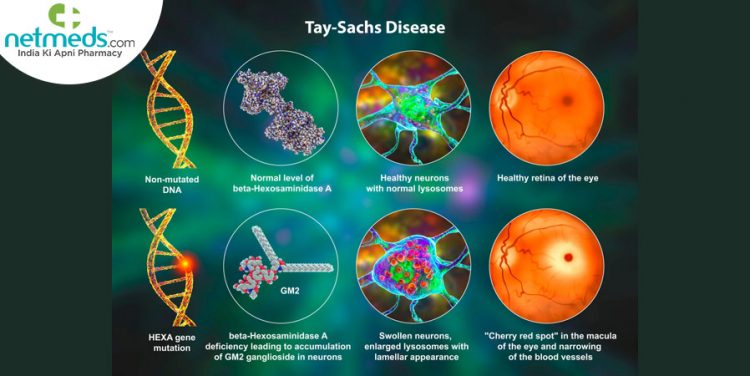Tay-Sachs disease is a rare inherited disorder diagnosed in babies around six months of age. With a high fatality rate, this ailment is characterized by neurological problems, when certain nerve cells or neurons die due to deficiency of an enzyme called hexosaminidase A. This causes excessive accumulation of lipids in the brain. These lipids are fatty acids known called gangliosides. When these unrequired gangliosides get accumulated, malfunctioning of the central nervous system starts to take place resulting in this disorder. The most common form of Tay-Sachs disease is the infantile form, which starts off in the form of reduced vision further leading to loss of skills. With time, infants may start to lose complete vision, with occurrences of involuntary muscle spasms and stiff movements. Eventually, they become unresponsive to their environment and surroundings. By three to five years of age, life-threatening complications begin to occur that eventually lead to respiratory failure and death. At present, there is no cure for Tay-Sachs, but research to identify causes of the disorder and deterioration are being studied. Extensive research is also being conducted on gene therapy or bone marrow transplant procedures so that treatment of Tay-Sachs can be worked out in the future.
Symptoms Of Tay-Sachs
Until four to six months of age, infants grow normally. Thereupon, the following symptoms start to show up:
- The infant is not able to sit, turn over and stops crawling
- The infant is very fearful and overreacts to loud noises
- Reduced vision disables the child to focus on objects
- A cherry-red spot is noticed in the eyes.
- The infant starts to have difficulty swallowing
- Seizures begin by the time the child reaches 2 years of age
- Loss of mental function, hearing, and sight
- Acute muscle weakness, paralysis, and loss of vision by the age of 5
Also read: Auditory Processing Disorder: Causes, Symptoms And Treatment
Causes Of Tay-Sachs Disease
Genes are codes passed from parents to children. They are responsible for features such as the colour of eyes, skin colour, blood type, hair type, and gender. Our body consists of certain genes called HEXA. Healthy adults have two healthy versions of this gene, which gives instructions to the body to create an enzyme known as Hex-A. This enzyme prevents the build-up of gangliosides in the brain. Even a single healthy copy of this gene is enough to make Hex-A protein. However, when infants get malfunctioned copies of the gene from both parents, they are unable to create Hex-A protein resulting in the formation of ganglioside causing brain damage. When both mother and father are carriers of Tay-Sachs disease, chances of the child being born with Tay-Sachs is more than twenty-five percent.
Tay-Sachs Disease Diagnosis
In the case of pregnant women: Chorionic villus sampling is done to rule out the possibility of Tay-Sachs. The doctor takes a sample of the amniotic fluid that surrounds the baby and tests it. If the tests don’t find Hex-A protein, the baby is bound to be affected by Tay-Sachs. If the tests confirm Hex-A, the baby will not have the disease.
In the case of a newborn: A routine blood test is conducted besides checking the infant’s symptoms and family history. Most importantly, the baby’s eyes are checked for a cherry-red spot. Traces of any such spot confirms Tay-Sachs.
Also read: Chorionic Villus Sampling: Reasons For This Prenatal Testing And What To Expect
Treatment Of Tay-Sachs
At present, there is no cure for this genetic illness, but there are certain programs that could be helpful to control some of the symptoms. Speech-based therapies keep the suck-swallow reflex going. When the child has trouble swallowing, or when the child inhales food or liquid into their lungs while eating, feeding tubes are inserted. Chest physiotherapy is done that helps break up mucus in the lungs. It can also improve respiratory health conditions. The quality of life of the child can also be improved through proper nutrition, music, and mind sharpening activities.
Source by www.netmeds.com


